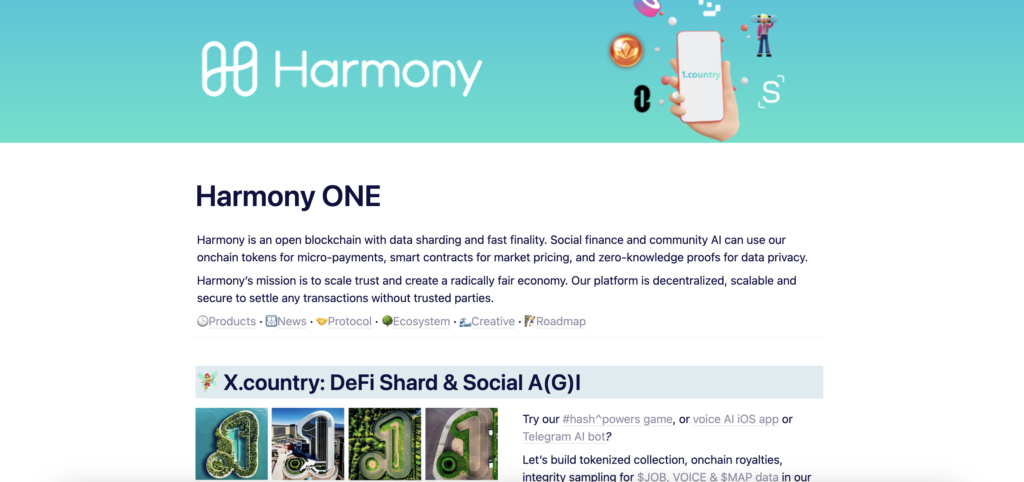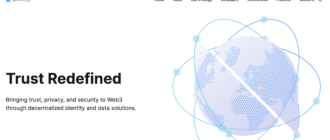This article delves into the intricacies of the Harmony project and its native cryptocurrency, ONE. We will explore the foundational aspects that define Harmony, from its technological framework to its unique consensus mechanism. Additionally, the article will cover the project’s tokenomics, examining the distribution, utility, and economic incentives of the ONE token. The ecosystem surrounding Harmony, including its applications and partnerships, will be analyzed to provide a comprehensive understanding of its current state and future potential. Lastly, we will discuss the growth prospects and development trajectory of Harmony, offering insights into its place within the broader blockchain industry.

What is Harmony?
Harmony is a blockchain platform designed to enable the creation and utilization of decentralized applications (DApps) with an emphasis on scalability and efficiency. The project leverages advanced technologies such as random state sharding and the Fast Byzantine Fault Tolerant (FBFT) consensus protocol to achieve rapid transaction finality and low latency. By implementing sharding, Harmony divides its network into multiple shards, each processing transactions and smart contracts concurrently, thus enhancing overall throughput and scalability. This innovative approach allows Harmony to process thousands of transactions per second with finality in approximately two seconds. The platform also integrates cross-chain capabilities, facilitating interoperability with other major blockchain networks, thereby enabling seamless asset transfer and communication between different blockchain ecosystems. Harmony’s unique blend of technological advancements positions it as a robust solution for the development and deployment of scalable, secure, and efficient decentralized applications.
History of the Project
Harmony was founded in 2018 with a vision to address the scalability and decentralization challenges faced by blockchain networks. The project began its journey by conducting a series of technical benchmarks and community-building activities across Asia. In late 2018, Harmony launched its Devnet, demonstrating significant milestones such as achieving a 1.3-second block propagation time and establishing a partnership with Animoca Brands.
In early 2019, Harmony released its whitepaper and open-sourced its codebase, marking the transition to a more collaborative and transparent development process. The project launched its first Testnet, showcasing features like BLS multi-signatures for faster consensus and secure resharding mechanisms. Subsequent Testnet iterations introduced enhanced functionalities, including Solidity smart contract deployment and advanced peer-to-peer networking protocols.
Harmony’s Mainnet officially launched in June 2019, bringing to life a fully operational blockchain network with sharding and staking capabilities. The project continued to evolve, introducing cross-shard transactions and forging strategic partnerships to expand its ecosystem. By 2021, Harmony had integrated with major DeFi platforms and embarked on initiatives to enhance interoperability with other blockchains, solidifying its position as a key player in the blockchain industry.
How Harmony Works
Harmony is built on a foundation of advanced blockchain technologies designed to address the key issues of scalability, security, and decentralization. The project utilizes several innovative techniques, including random state sharding, the Fast Byzantine Fault Tolerant (FBFT) consensus protocol, and Effective Proof of Stake (EPoS), to achieve its goals.
Key Technologies
Random State Sharding: Harmony divides its network into multiple shards, each responsible for processing its own transactions and smart contracts. This division allows Harmony to process transactions in parallel, significantly increasing throughput and reducing latency. Sharding also reduces the computational load on each node, as they only need to maintain a subset of the blockchain’s state.
Fast Byzantine Fault Tolerant (FBFT) Consensus: Harmony’s consensus mechanism is an enhanced version of Practical Byzantine Fault Tolerance (PBFT). FBFT achieves near-instant finality by utilizing Boneh-Lynn-Shacham (BLS) multi-signatures, which aggregate signatures from multiple validators into a single compact signature. This reduces communication overhead and allows for faster consensus among validators.
Effective Proof of Stake (EPoS): Unlike traditional Proof of Stake (PoS) systems, which often lead to centralization due to large stakeholders dominating the network, EPoS is designed to promote decentralization. It penalizes validators who stake too much in a single node by reducing their rewards, encouraging them to distribute their stakes across multiple nodes. This ensures a more balanced and secure network.
Harmony Blockchain
Harmony’s blockchain is designed to be both scalable and secure. The network is composed of four shards, with Shard 0 serving as the Beacon Chain that coordinates the activities of the other shards. Each shard operates independently, processing transactions and creating blocks. Cross-shard communication is facilitated by the Beacon Chain, ensuring data consistency and preventing double-spending across shards.
Consensus Mechanism: The FBFT protocol combined with EPoS allows Harmony to achieve consensus quickly and efficiently. Validators are randomly assigned to shards, where they propose and validate blocks. The use of verifiable random functions (VRF) and verifiable delay functions (VDF) ensures the randomness and fairness of validator selection, preventing front-running and other manipulative behaviors.
Validator and Delegator Roles: Validators run nodes that participate in the consensus process, while delegators stake their tokens with validators to earn rewards. This two-tier system ensures broad participation and security. Validators must maintain high uptime and performance to avoid penalties, while delegators can switch their stakes to different validators if needed.
Technical Details: Harmony processes transactions with a finality time of approximately two seconds, making it one of the fastest blockchain networks available. The network can handle up to 2,000 transactions per second (TPS), with plans to increase this capacity as the ecosystem grows. Additionally, Harmony’s low transaction fees make it an attractive platform for decentralized applications (DApps).
Security Features: Harmony employs several security measures to protect its network. The use of BLS signatures enhances cryptographic security, while the EPoS mechanism prevents centralization and single points of failure. Validators who engage in malicious behavior, such as double-signing, face severe penalties, including slashing of their staked tokens.
Harmony’s unique combination of sharding, FBFT, and EPoS sets it apart from other blockchain projects, providing a scalable, secure, and efficient platform for DApps and decentralized finance (DeFi) applications. As Harmony continues to develop, its focus on interoperability and cross-chain capabilities positions it as a key player in the evolving blockchain landscape.
Tokenomics of Harmony (ONE)
Is ONE a Token or a Coin?
Harmony’s ONE is a token, not a coin. It is an integral part of the Harmony blockchain ecosystem and serves multiple purposes within the network.
Tokenomics Overview
The ONE token powers the Harmony blockchain, playing a vital role in staking, governance, and transaction fees. Launched in May 2019, the ONE token’s total supply is 13.8 billion, with a circulating supply of approximately 13.1 billion tokens.
Emission Model
The initial distribution of ONE tokens was structured to support the growth and development of the Harmony network:
- Seed Sale: 22.4% of the total supply
- Binance Launchpad: 12.5%
- Team Allocation: 16.9%
- Protocol Development: 26.4%
- Ecosystem Development: 21.8%
Harmony has adopted a fixed annual issuance model, where 441 million ONE tokens are minted each year to incentivize network validators. This model ensures a steady supply to support network operations while balancing inflation with transaction fee burns to offset new issuance.
Staking and Rewards
ONE tokens are used in Harmony’s Effective Proof of Stake (EPoS) consensus mechanism, where validators stake tokens to participate in block creation and validation. Delegators, who do not wish to run a node, can stake their tokens with existing validators to earn a share of the block rewards. This system not only secures the network but also encourages decentralization by reducing the influence of large stakeholders.
Token Utility
The ONE token serves several critical functions within the Harmony ecosystem:
- Staking: Validators and delegators stake ONE tokens to secure the network and earn rewards.
- Transaction Fees: ONE is used to pay for transaction fees, gas fees, and storage fees on the Harmony blockchain.
- Governance: ONE holders can participate in on-chain governance, voting on proposals that affect the network’s future.
Market Performance
As of 2024, the market cap of ONE is approximately $281 million, with a price fluctuating around $0.02. The token has experienced significant price volatility, reaching an all-time high of $0.38 in 2021. Despite market fluctuations, the Harmony team continues to focus on enhancing network capabilities and expanding its ecosystem, which may positively influence the token’s value in the long run.
Harmony’s tokenomics are designed to support a sustainable and scalable blockchain ecosystem. With its fixed annual issuance, staking rewards, and multifaceted utility, the ONE token is a cornerstone of the Harmony network, driving both its security and functionality.
Where to Buy Harmony (ONE)
Harmony’s ONE token can be purchased on several major cryptocurrency exchanges. Here are some of the top platforms where you can trade ONE:
- Binance: As one of the largest cryptocurrency exchanges in the world, Binance offers a wide range of trading pairs for ONE, including ONE/USDT, ONE/BTC, and ONE/ETH.
- HTX (Huobi): HTX, previously known as Huobi, supports trading of ONE with pairs such as ONE/USDT and ONE/BTC. It provides a robust trading platform with high liquidity.
- MEXC: MEXC Global is a comprehensive cryptocurrency trading platform that offers various trading pairs for ONE. It is known for its user-friendly interface and competitive fees.
- Bybit: Bybit is a popular exchange that supports trading of ONE, primarily focusing on derivatives but also offering spot trading options.
- KuCoin: KuCoin is another prominent exchange where you can buy ONE tokens. It supports trading pairs like ONE/USDT and ONE/BTC, offering a seamless trading experience.
To buy ONE on these exchanges, you typically need to:
- Register an account on the exchange.
- Complete the necessary KYC verification.
- Deposit funds into your account using fiat or other cryptocurrencies.
- Navigate to the ONE trading pair and place a buy order.
Where to Store Harmony (ONE)
Storing your ONE tokens securely is crucial. Here are some wallet options that provide safe storage for your Harmony tokens:
- Harmony One Wallet: The official wallet provided by Harmony. It is available as a Chrome extension and offers a straightforward way to manage your ONE tokens. It supports staking, transaction history, and easy integration with the Harmony network.
- MetaMask: A widely-used browser extension wallet that supports Harmony’s ONE token. MetaMask allows you to interact with decentralized applications (DApps) and manage your tokens securely.
- Ledger Nano S/X: Hardware wallets like Ledger Nano S and Nano X offer one of the most secure ways to store your ONE tokens. These devices store your private keys offline, significantly reducing the risk of hacks.
- Trust Wallet: A mobile wallet that supports multiple cryptocurrencies, including ONE. Trust Wallet offers a user-friendly interface and the ability to interact with DApps directly from your mobile device.
- Math Wallet: Math Wallet supports Harmony’s ONE token and offers both a browser extension and a mobile app. It is known for its multi-chain support and user-friendly features.
Storing ONE Tokens: Key Features
- Security: Hardware wallets like Ledger provide the highest level of security by keeping your private keys offline.
- Ease of Use: Wallets like Harmony One Wallet and MetaMask offer easy access and management of your tokens, making them suitable for everyday transactions.
- Staking: Wallets such as Harmony One Wallet and Trust Wallet support staking, allowing you to earn rewards by staking your ONE tokens directly from the wallet.
- DApp Integration: MetaMask and Math Wallet offer seamless integration with decentralized applications, enhancing the utility of your ONE tokens.
By selecting the appropriate wallet based on your needs—whether it’s maximum security with a hardware wallet or convenience with a mobile wallet—you can ensure that your ONE tokens are stored safely and are easily accessible for transactions and staking.
Future Prospects of Harmony (ONE)
Project Growth
Harmony (ONE) is positioned for growth through its focus on scalability, interoperability, and low transaction costs. The project aims to enhance the development and deployment of decentralized applications (DApps) by utilizing technologies like random state sharding and the Fast Byzantine Fault Tolerant (FBFT) consensus mechanism. This approach ensures fast transaction finality, low fees, and high throughput, making it attractive for developers and enterprises alike.
Key Clients and Partners
Harmony has established several strategic partnerships to bolster its ecosystem and expand its reach. Notable partners include:
- Injective Protocol: For decentralized finance (DeFi) solutions.
- Knit Finance: Enhancing cross-chain asset utilization.
- Webb: For privacy-focused applications.
- Gnosis Safe: Improving multi-signature wallet functionality.
These partnerships aim to integrate Harmony’s technology with other leading blockchain projects, enhancing interoperability and functionality.
Growth Drivers
- Interoperability: Harmony’s cross-chain bridges with Ethereum and Bitcoin enable seamless asset transfers between different blockchain networks, increasing its utility.
- Developer Support: Through hackathons, workshops, and grants, Harmony actively engages the developer community to create innovative applications on its platform.
- Decentralized Finance (DeFi): Harmony supports various DeFi applications, including decentralized exchanges (DEXs), lending platforms, and stablecoins, which drive user adoption and network activity.
Ecosystem
Harmony’s ecosystem is robust and diverse, encompassing a wide range of applications and services. Key components of the ecosystem include:
- Crazy.ONE: Personalized subdomains that function as NFTs, linked to users’ ONE wallets.
- Validator DAO: A decentralized autonomous organization (DAO) composed of elected validators to govern the network.
- DeFi Applications: Including cross-asset DEXs, portfolio management tools, and prediction markets.
- Cross-Chain Bridges: Facilitating interoperability with Ethereum and Bitcoin, enhancing the network’s capabilities.
Development Roadmap
Harmony’s roadmap outlines several ambitious goals aimed at further enhancing the platform’s capabilities and expanding its ecosystem:
- Additional DAOs: To further decentralize network governance.
- Enhanced Security: Implementing re-sharding to prevent single-shard attacks.
- Fast Sync Capabilities: Improving network performance and user experience.
- Zero-Knowledge Proofs: Adding ZK-proofs for enhanced privacy and scalability.
Forecast
Analysts predict a steady growth trajectory for Harmony, driven by its technological advancements and expanding ecosystem. The project is expected to attract more developers and users as it continues to deliver on its roadmap and strengthen its partnerships. With its focus on scalability, interoperability, and low transaction costs, Harmony is well-positioned to become a leading platform in the blockchain space.
Conclusion
In summary, Harmony presents a compelling case within the blockchain landscape, characterized by its innovative approach to scalability and decentralization. As we have explored the various facets of the project, it becomes evident that Harmony’s technology and ecosystem are poised to contribute significantly to the evolution of decentralized networks. With its continued development and strategic vision, Harmony stands as a noteworthy contender in the race towards mass blockchain adoption.







